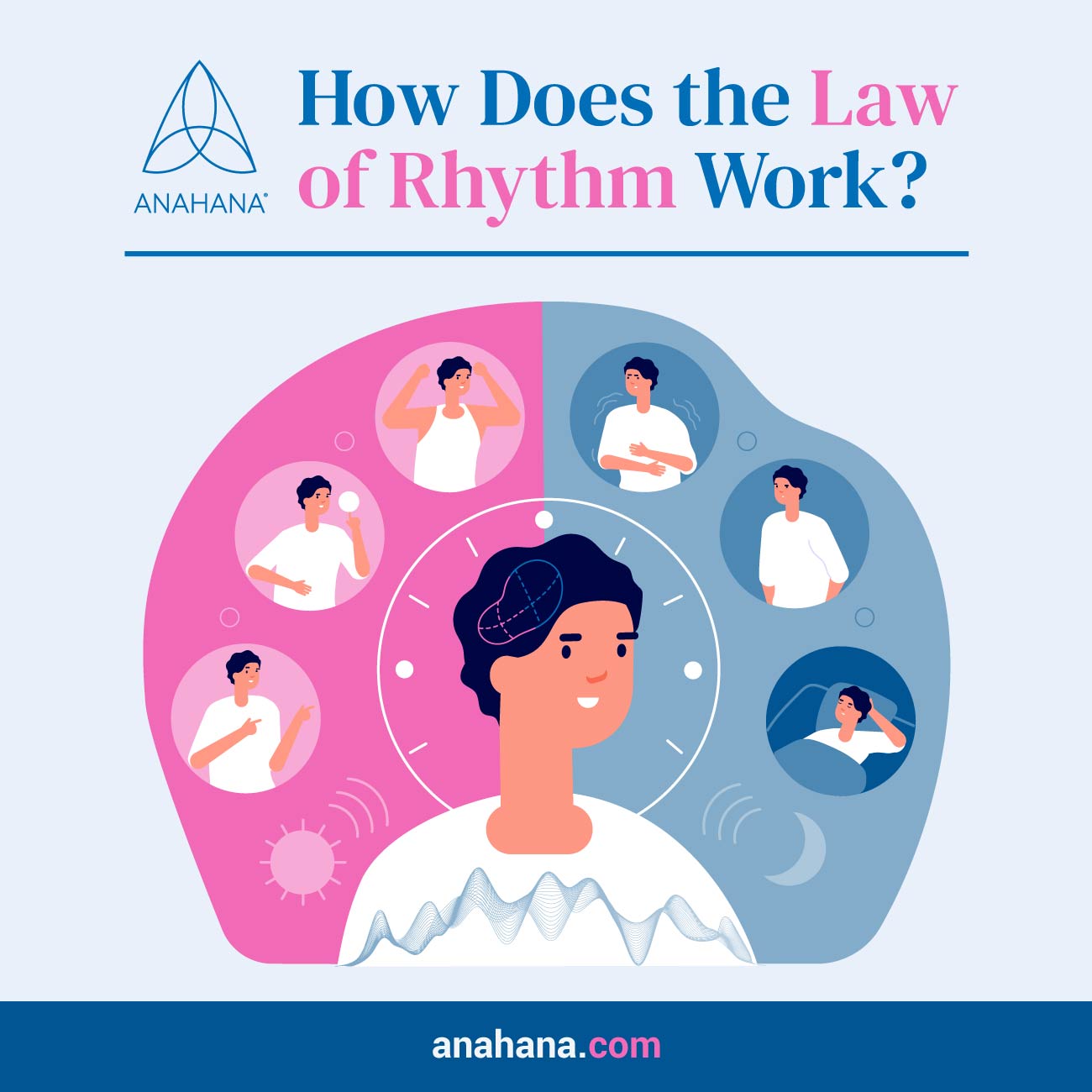
Table of Contents
Explore the Law of Rhythm and its role in the universe. Discover how understanding this law can bring harmony and balance to your life.
Law of Rhythm Defined
While many are familiar with the ebbs and flows of life, these patterns form a part of a grander scheme. The Law of Rhythm, a cosmic principle, plays a pivotal role in shaping our experiences.
Understanding and aligning with certain rhythms of this law deepens our spiritual journey and brings a sense of harmony and fulfillment.
This exploration will guide you in living in sync with these powerful, transformative universal laws, offering insights into navigating life's inevitable rhythms and how to avoid severe pendulum swings that life can bring in one's own life.
What is the Law of Rhythm?
The Law of Rhythm is a fundamental principle, a universal law intricately woven into the fabric of existence. It posits that life and all its components move in a rhythmic, cyclical pattern akin to a pendulum's swing.
This law, a key aspect of the universe's design, illuminates the balanced nature of our world. It teaches us that for every action, there's an equal and opposite reaction, a concept mirrored in the rhythmic dance of the cosmos.
The Law of Rhythm, therefore, is not just a concept but a living pattern that echoes in every aspect of our lives.
Inherent in the Law of Rhythm is the principle of balance. It suggests that life doesn't occur in random leaps and bounds but flows in a predictable, rhythmic pattern. Recognizing this pattern empowers us to anticipate and prepare for life's natural ebbs and flows.
The pendulum swing, a metaphor often used to describe this law, symbolizes the constant, rhythmic motion that governs change and progression in the universe.
The Law of Rhythm Explained
Delving deeper into the Law of Rhythm reveals its profound influence on our existence. It's akin to the power of the pendulum swing manifesting in the natural world — the rise and fall of the tides, the change of seasons, and even the cycle of life and death.
This rhythm compensates for extremes, ensuring the universe maintains a state of dynamic equilibrium.
The flow of rhythm is omnipresent, influencing everything from the macrocosmic orbits of celestial bodies to the microcosmic cycles within our lives. It's a dance of energy, constantly moving, shifting, and balancing itself.
The Law of Rhythm teaches us that everything is in motion, perpetually swinging from one state to another. When we understand this, we grasp the true nature of change — not as a sporadic or random occurrence but as part of a larger, more predictable pattern.
This law highlights that nothing remains static; energy is always flowing. It manifests in various forms, from physical to emotional to mental states.
The Law of Rhythm, therefore, offers a framework for understanding the dynamic and ever-changing nature of the universe and our place within it.
How Does the Law of Rhythm Work?

The Law of Rhythm operates through the principle of perpetual motion, similar to the consistent swings of a pendulum. The pendulum swing manifests as a series of highs and lows, successes and setbacks, reflecting a natural, rhythmic pattern.
Just as a pendulum swings from left to right, life oscillates between different states, forever reminding us that no condition is permanent.
This law suggests that each phase of our lives follows a pattern that can be observed and anticipated. It's evident in the changing mental states we experience, the shifts in our emotional landscape, and the progress and regression in our personal and professional lives.
How to Use the Law of Rhythm?
Utilizing the Law of Rhythm in daily life involves conscious awareness of its presence and understanding how it impacts us.
- Embracing Life's Cycles: The key is to maintain rhythm, to stay in harmony with the natural flow of life's cycles. This means embracing high and low periods and recognizing them as essential to our growth and development.
- Aligning with the Rhythm: To harness this law effectively, it's crucial to recognize how rhythm manifests in various aspects of our lives, from physical and mental well-being to relationships and careers. During a swing towards a high period, things rise and realize it's an opportunity to capitalize on the momentum to push forward. Conversely, a backward swing towards a low period is not a setback but a time for rest, reflection, and preparation for the next upward swing.
By anticipating these cycles, we can prepare for them, thus reducing the impact of a severe pendulum swing. When understood and applied, the Law of Rhythm becomes a powerful tool for personal and spiritual growth, guiding us to flow with life's inevitable rhythms.
The 12 Laws of the Universe and the Law of Rhythm
The Law of Rhythm is one of the integral components of the 12 laws of the universe, a set of principles that govern our existence and the cosmos. These laws, including the Law of Rhythm, work in harmony to create the balance and order of the universe.
The Law of Rhythm, specifically, plays a crucial role in establishing the cycles and seasons of life, reminding us that everything moves in a rhythmic pattern.
This law is interlinked with the other universal laws, each contributing to reaching one's peak potential.
It teaches us the importance of flowing with life's natural rhythms, understanding that our journey involves phases of growth and retraction, joy and sorrow, expansion and contraction.
- The Law of Divine Oneness: This law signifies that everything in the universe is connected. Our thoughts, actions, and words affect others and the universe.
- The Law of Vibration: Everything in the universe moves and vibrates at a certain frequency. This law highlights that our vibration determines our experiences.
- The Law of Correspondence: This principle posits that patterns repeat throughout the universe, and our outer world reflects our inner world.
- The Law of Attraction: Similar to the Law of Vibration, this law suggests that like attracts like. Positive thoughts and actions attract positive outcomes.
- The Law of Inspired Action: This law emphasizes the need to take proactive steps towards your goals, aligning your actions with your desires.
- The Law of Perpetual Transmutation of Energy: Energy is always in motion and can transform from one form to another, enabling change and growth.
- The Law of Cause and Effect (Karma): Every action has an equal and opposite reaction, underscoring the importance of responsible actions.
- The Law of Compensation: This law relates to the rewards and consequences of our actions.
- The Law of Relativity: This law teaches that everything is relative and that challenges and obstacles are growth opportunities.
- The Law of Polarity: This principle states that everything has an opposite and that opposites are different forms of the same thing.
- The Law of Rhythm: This law states that life is a series of cycles and patterns, and understanding these rhythms can enhance our life experiences.
- The Law of Gender: This law highlights the masculine and feminine energies within all things, contributing to creation and growth.
The Takeaway
Embracing the Law of Rhythm transforms our perspective on life. It encourages us to flow with the natural rhythms, accepting that life is a series of cycles and changes. This understanding brings peace and acceptance as we learn to embrace the highs and lows as part of our journey.
The rhythm of life is ever-present, influencing our thoughts, emotions, and experiences. Recognizing this rhythm allows us to be more in tune with ourselves and the universe. It teaches us to be resilient in times of change and to celebrate the moments of triumph.
The Law of Rhythm, thus, is not just a principle to understand but a practice to imbibe, guiding us to live in harmony with the natural flow of the universe.
Frequently Asked Questions
What is the universal principle of rhythm?
The Universal Principle of Rhythm refers to rhythm states, the consistent and predictable cycles found throughout the universe. It suggests that all events, conditions, and experiences follow a natural, rhythmic pattern, much like the ebb and flow of tides or the changing of seasons.
What is an example of the Law of Rhythm?
An example of the Law of Rhythm can be observed in the natural cycle of seasons. Just as winter gives way to spring and night transitions to day, our lives follow similar patterns of change and renewal, reflecting the rhythmic nature of our existence.
What is the Law of Rhythm in art?
In art, the Law of Rhythm refers to the intentional use of repeated patterns and movements to create a sense of harmony and flow within a piece.
Artists use rhythm and movement to guide the viewer's eye across the artwork, establishing a visual tempo that mirrors the rhythmic patterns in nature and life.
References
How the Law of Rhythm Influences Your Daily Life
Create The Life You Want Part 5: Apply The Law of Rhythm | Hearts Rise Up
The Hermetic Law of Rhythm - How to Use It and How to Escape from It
The Universal Law Of Rhythm And What It Means - Connie Hertz
Universal Law: Law of Rhythm | Higher Vibes Life
Disclaimer
The contents of this article are provided for informational purposes only and are not intended to substitute for professional medical advice, diagnosis, or treatment. It is always recommended to consult with a qualified healthcare provider before making any health-related changes or if you have any questions or concerns about your health. Anahana is not liable for any errors, omissions, or consequences that may occur from using the information provided.

By: Sydney Garden
Sydney is a skilled writer and editor at Anahana with a diverse educational and professional background. Sydney received her BA (Honors) in Communications from Toronto Metropolitan University and is furthering her education by pursuing her MSc in Human Resource Management at the University of Stirling.
